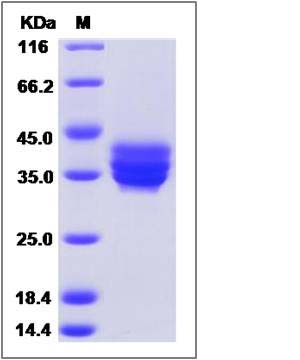Human TNFRSF17 / BCMA / CD269 Protein (Fc Tag)
BCM,BCMA,CD269,TNFRSF13A
- 100ug (NPP3960) Please inquiry
| Catalog Number | P10620-H15H |
|---|---|
| Organism Species | Human |
| Host | Human Cells |
| Synonyms | BCM,BCMA,CD269,TNFRSF13A |
| Molecular Weight | The recombinant human TNFRSF17 consists 303 amino acids and predicts a molecular mass of 33.3 kDa. |
| predicted N | Ser |
| SDS-PAGE |  |
| Purity | > 95 % as determined by SDS-PAGE. |
| Protein Construction | A DNA sequence encoding the human TNFRSF17 (NP_001183.2) (Met1-Ala54) was expressed with the Fc region of rabbit IgG at the N-terminus. |
| Bio-activity | |
| Research Area | Cardiovascular |Angiogenesis |Cytokine & Receptor |Tumor Necrosis Factor & Receptor |TNF receptor |
| Formulation | Lyophilized from sterile PBS, pH 7.4. 1. Normally 5 % - 8 % trehalose and mannitol are added as protectants before lyophilization. Specific concentrations are included in the hardcopy of COA. |
| Background | Tumor necrosis factor receptor superfamily, member 17 (TNFRSF17), also known as B cell maturation antigen (BCMA) or CD269 antigen, is a member of the TNF-receptor superfamily. This receptor is preferentially expressed in mature B lymphocytes, and may be important for B cell development and autoimmune response. This receptor has been shown to specifically bind to the tumor necrosis factor (ligand) superfamily, member 13b (TNFSF13BBAFF), and to lead to NF-kappaB and MAPK8/JNK activation. TNFRSF17/BCMA/CD269 also binds to various TRAF family members, and thus may transduce signals for cell survival and proliferation. TNFRSF17/BCMA/CD269 is a receptor for TALL-1 and BCMA activates NF-kappaB through a TRAF5-, TRAF6-, NIK-, and IKK-dependent pathway. The identification of TNFRSF17 as a NF-kappaB-activating receptor for TALL-1 suggests molecular targets for drug development against certain immunodeficient or autoimmune diseases. TNFRSF17/BCMA is a target of donor B-cell immunity in patients with myeloma who respond to DLI. Antibody responses to cell-surface BCMA may contribute directly to tumor rejection in vivo. |
| Reference |
